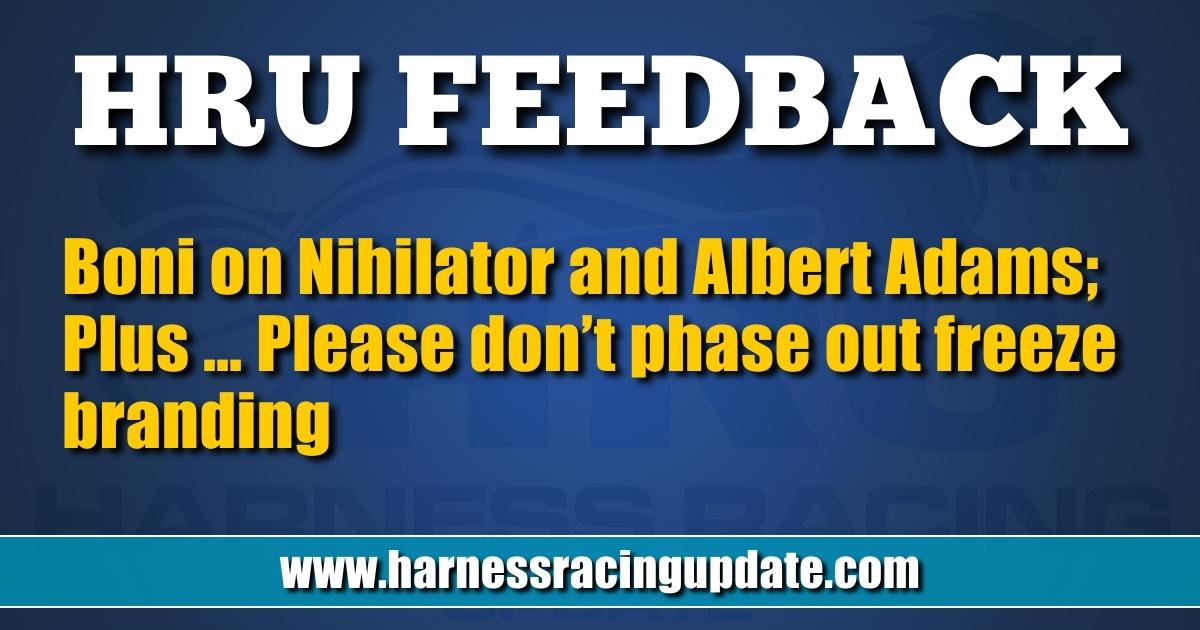
HRU Feedback (2021-12-12)
Nihilator / Albert Adams
Reading Murray Brown’s Sunday column with Albert Adams (full story here), I was a bit taken by Albert’s assessment of Nihilator and his disappointment at stud and some of his reasoning why.
I will be the first to acknowledge that Nihilator had a less than successful career at stud, though somewhat short lived. However, Albert’s comment that he sired poor individuals and that he himself “had two front feet that looked like they might have belonged to two different horses,” was what caught my attention.
That was simply not the case. Other than being a bit back in his knees, as was his sire Niatross but to a much greater degree, he was an outstanding and correct individual by all other measures. I think the attached Tony Leonard photo will attest to that.
Before I wrote you and while I had my own observation, I also checked with Ernie Gaskin for his recollections.
Other than Chuck Roback, Nihilator’s caretaker from his first race to retirement, no one spent more time around him than Ernie, as the lead trainer for the Haughton Stable, and he wholeheartedly agreed with my recall.
Perhaps Albert was thinking of Niatross, who did in fact have different front feet, with one that could have been described as clubby. Whether that be the case or not, I do know that his description of Nihilator was not accurate.
Bob Boni / Secaucus, NJ
Please don’t phase out freeze branding
I am a USTA member and a volunteer coordinator for Safe Harbor Sanctuary in Tennessee. We are a 501(c)3 Non Profit equine rescue, rehabilitation and rehoming sanctuary. My team of volunteers are boots on the ground working with standardbred horses. We rescue, rehome, and benefit standardbreds and their owners throughout southern Kentucky and middle Tennessee. We take in horses from local animal controls. We don’t buy off of dealers or catalogs. We also go to auctions to intercept between the local Amish community and the brokers who then sell the thinner older horses on Facebook for higher profits.
At these auctions, horses are squeezed in on top of each other. Scared, starving, and agitated. We can’t always get close to a horse to scan for a microchip or take pictures. Sadly, we can’t rescue all of the horses. We do the best we can. But, when we spot a freeze branded standardbred, our eyes light up because they are five-star candidates for rehoming. Due to their training they make wonderful family and farm horses.
Changing the freeze brand requirements will negatively affect our work. We have taken in 35 standardbreds since January, 2016. The first was Marley (registered name Rohan), he was seized by animal control in a terrible neglect case with one dead horse on the property. Marley was IDed via his freeze brand and we discovered he was a harness racer from Kentucky. My personal rescued standardbred, Bosco (that’s his registered name), who was also a harness racer from 1998-2004, found himself starved and neglected at an auction in 2016. He was spotted due to his freeze brand in a pack of horses crammed together in a pen. Bosco is a wonderful horse and as his owner, I assure you his rescue has positively impacted my local economy.
Overall, living horses are much better for the agriculture economy than dead horses. Comparing the few hundreds made from a slaughtered horse to the vast amount of money spent on a horse for the rest of their lives going toward the feed store, the hay farmer, the farrier, the veterinarian, transportation revenue, and so forth. Our latest standardbred, Dude In The Denali, was rescued this past winter from an auction. As he was easily spotted in a mix of bay horses due to his freeze brand. He is now striving with his new owner. We have never encountered an adopter turning down a horse because of their branding.
ALL of the others, the 32 out of the 35 I didn’t mentioned, were IDed via freeze brand. Freeze brand connects the horse to his registration papers, tell us his age, their pedigree, and their history. Without it, he’s just another bay gelding. We don’t want to stop racing and we’re not asking for money. In fact rescuing and rehoming standardbreds puts money back into the economy. Please consider not phasing out freeze branding and not hindering us from the ability to ID them.
Christy Driscoll / Tennessee













